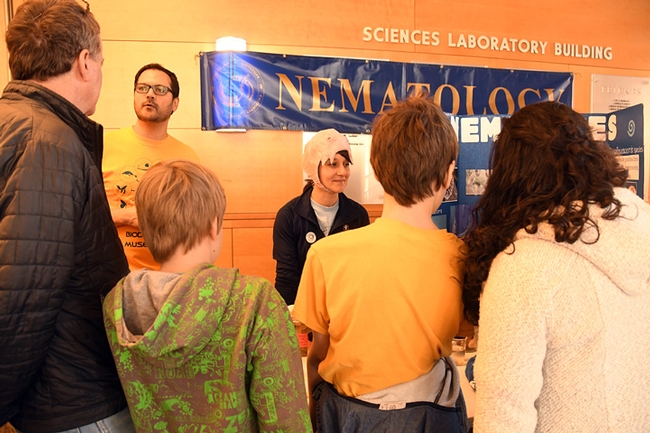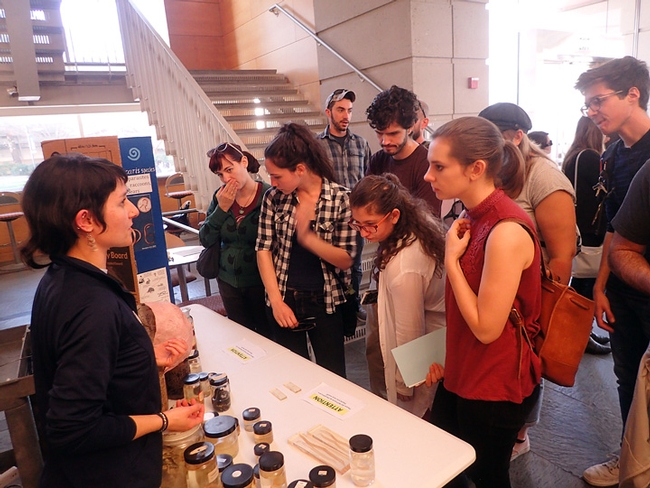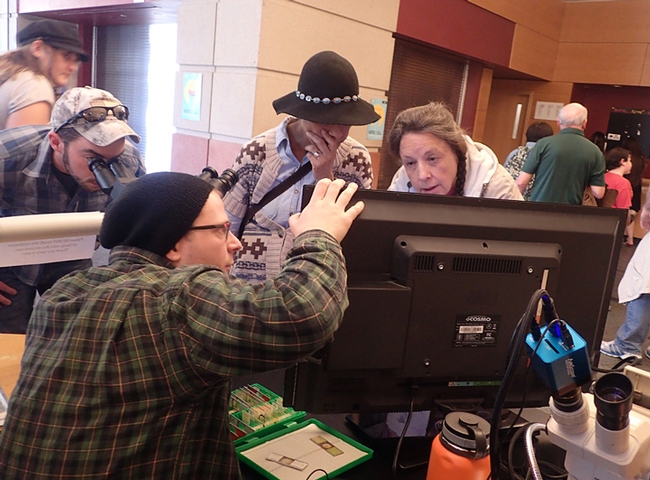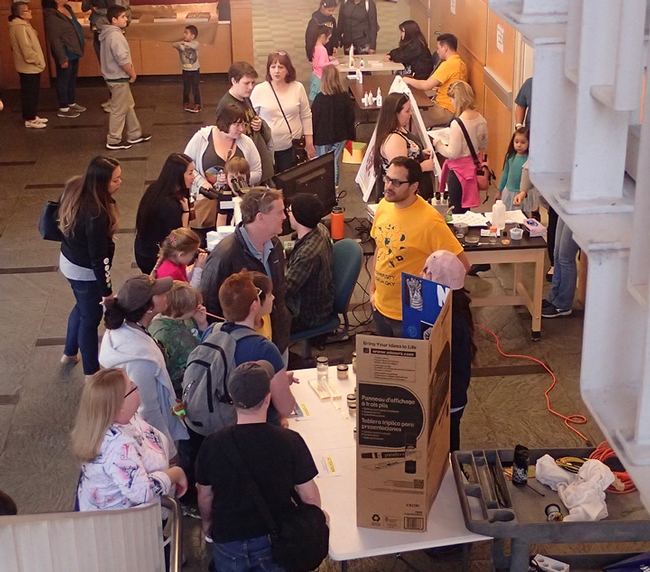- Author: Kathy Keatley Garvey

If you're a gardener, you're aware that nematodes are "microscopic, eel-like roundworms" and that "most troublesome species in the garden are those that live and feed within plant roots most of their lives and those that live freely in the soil and feed on plant roots," according to the UC Integrated Pest Management Program website on nematodes.
If you attended the ninth annual UC Davis Biodiversity Museum Day, you learned hands-on information from nematologists Christopher Pagan and Corwin Parker, doctoral students who study with major professor Steve Nadler, professor and chair of the UC Davis Department of Entomology and Nematology.
Pagan and Parker held forth at their display in the Academic Surge Building, where they fielded questions about nematodes and showed specimens to the visitors. The nematode collection was one of 13 museums or collections featured at the Biodiversity Museum Day, always held the Saturday of Presidents' Weekend.
Many visitors asked what nematodes are, they related.
Other common questions asked:
- Do I have nematode parasites?
- How dangerous are nematode parasites/can they kill you?
- How long do they live?
- How many species ofode are there?
- Are soil nematodes good or bad for my garden?
Parker shared some of the answers:
Do I have nematode parasites?
Probably not unless you've been traveling a lot. The most common nematode parasite of humans in the US is pinworm which most children get, but not adults. Worldwide however, hundreds of millions of people are infested with parasites including Ascaris, hookworm, and whipworm.
How dangerous are nematode parasites/can they kill you?
Nematode parasites are usually relatively benign unless you have a lot of them. Potentially fatal exceptions do exist, such as zoonotic infections of rat lungworm and raccoon roundworm, but those are rare.
How long do nematodes live?
It depends on the species and life history. Parasitic nematodes can live for a long time, while most free-living nematodes have relatively short lifespans. Some nematodes that live in harsh environments such as deserts can extend their lives by going into a state of suspended animation until environmental conditions are optimal.
How many species of nematode are there?
More than 30,000 described species, but it's estimated there are more than 1 million total.
Are soil nematodes good or bad for my garden?
Most soil nematodes are neutral to beneficial for your garden. They're an integral part of the soil ecosystem and help with nutrient cycling, and some kill of root-feeding insects. There are some plant-parasitic nematodes, but most don't cause significant damage.
UC Davis Biodiversity Museum Day
In addition to the nematode collection, the UC Davis Department of Entomology and Nematology showcased the Bohart Museum of Entomology and the Häagen-Dazs Honey Bee Haven. Other participating museums or collections at this year's Biodiversity Museum Day: the Botanical Conservatory, Arboretum and Public Garden, California Raptor Center, Museum of Wildlife and Fish Biology, Paleontology Collection, Phaff Yeast Culture Collection, Viticulture and Enology Culture Collection, Anthropology Museum, Center for Plant Diversity, and Marine Invertebrate Collection.
Here's a glimpse of the Biodiversity Museum Day activities at the Bohart Museum of Entomology and the Häagen-Dazs Honey Bee Haven.
If you missed it, calendar the 10th anniversary Biodiversity Museum Day in 2021. The event always takes place the Saturday of Presidents' Day Weekend.
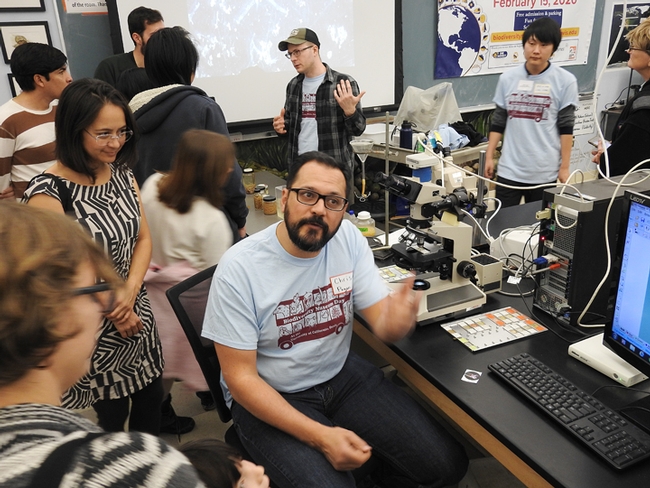
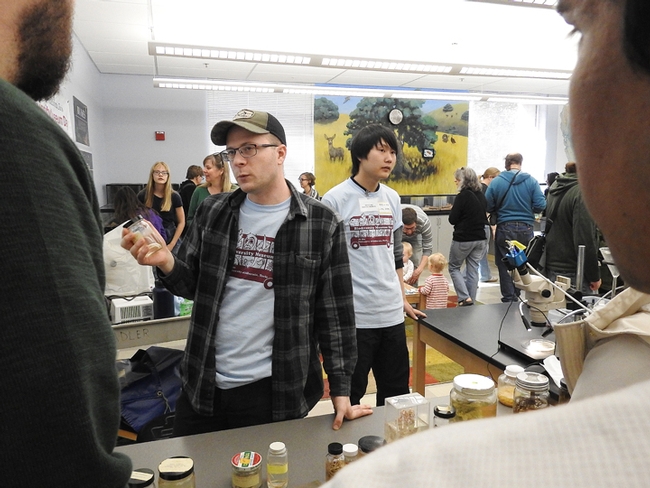
- Author: Kathy Keatley Garvey
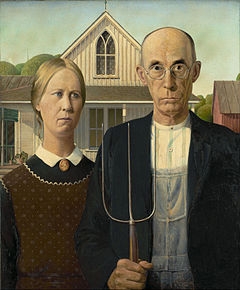
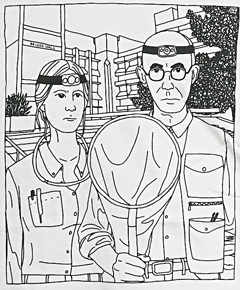
When the 105th annual UC Davis Picnic Day takes place Saturday, April 13, thousands of visitors will explore the campus. It promises to be informative, educational and entertaining.
But over at Briggs Hall, home of the UC Davis Department of Entomology and Nermatology, “special guests” will include bugs.
There will not only be cockroach races, maggot art, and displays of bees, ants, aquatic insects—and more!—but huge images of vectors, the incredible macro photography of medical entomologist/geneticist Geoffrey Attardo, assistant professor, UC Davis Department of Entomology and Nematology.
Virtual Reality Bugs
Attardo will be demonstrating “Virtual Reality Bugs” where youths and adults can watch 40-foot tall, three-dimensional insects and spiders. And in his medical entomology display, he will be exhibiting metal prints of vectors, including a tsetse fly, kissing bug, deer tick, mosquito, stable fly, cat flea and bed bug.
You wouldn't want to encounter a bed bug in your bed, or a flea or tick on your dog, or a mosquito on your arm. You may not even know what they look like up close. But with these images, you can see what's bugging you or your pets.
And with the Virtual Reality Bugs, participants can select what they want to see--or what's towering over them. The list includes a black widow spider, ant, beetle, grasshopper, damsel fly, cicada, cockroach, and a tsetse fly. Each person will be limited to about 30 seconds to accommodate the crowd.
The Briggs Hall activities run from 9 a.m. to about 4:30, while activities at the Bohart Museum of Entomology, will be offered from 11 a.m. to 2 p.m.
TheBohart Museum will focus on the theme, "Will Travel for Bugs: TheBohart Museum of Entomology's Collections from Around the World." It's nominated for a people's choice award, as is the honey tasting exhibit at Briggs Hall. Participants will sample meadowfoam, sage, cotton and buckwheat. QR codes will be at each site. (See news story about the activities at both sites.)
Vectors
But back to the vectors. Did you know that the Bohart Museum provides information or fact sheets on its website at http://bohart.ucdavis.edu/insect-info-sheets.html?
You can learn about some of the vectors that will dwarf you when you visit Briggs Hall.
For example, ticks!
"Ticks are blood-feeding external parasites of mammals, birds, and reptiles throughout the world," writes Lynn Kimsey, director of the Bohart Museum and UC Davis professor of entomology. "They are not insects rather they are arachnids, the same group that includes spiders and scorpions. There are two different groups of ticks, the hard ticks (Ixodidae) and soft ticks (Argasidae). Both are important vectors of pathogens to humans and animals throughout the world. Some diseases of current interest in the United States caused by tick-borne pathogens include Lyme Disease, Rocky Mountain Spotted Fever, and tick-borne Relapsing Fever (soft ticks)
"Many ticks seek hosts by 'questing.' Questing ticks crawl up the stems of grass or perch on the edges of leaves in a typical posture with the front legs extended. Certain chemicals, such as CO2, as well as heat and movement cause questing behavior. Ticks climb onto a potential host that brushes against their extended front legs. Once on a host hard ticks may feed for several days to several weeks.
And fleas!
"Fleas are bloodsucking parasites of humans, livestock and pets," Kimsey writes. "Only adult fleas feed on blood, which they obtain with their piercing/sucking mouthparts. Adult fleas blood feed on birds and mammals.Adult fleas are laterally flattened, wingless insects. They have a small eye spot on the side of the head, and a row of stout spines along the side of the head and the back of the thorax. Adult fleas travel rapidly by jumping, using their legs and a spring-like mechanism in the body. They are capable of spectacular leaps, covering distances up to one hundred times their body length
"The most common flea found on household pets, such as cats and dogs, is the cat flea, Xenopsylla cheopis."
Read the Bohart fact sheets and then check out Attardo's images.
EGSA T-Shirts
If you'd rather wear your bug on your shirt, the Entomology Graduate Student Association (EGSA) can oblige. They have scores of insect-themed t-shirts, ranging from beetles and honey bees to wanna bees. The newest t-shirts in the line-up include two designed by talented doctoral student/ant specialist Jill Oberski of the Phil Ward lab. One is a take-off of American Gothic, the 1930 painting by Grant Wood, except with entomologists holding a net in front of Briggs Hall, UC Davis campus, instead of the farmers holding a pitchfork in front of their farmhouse. The other Oberski t-shirt celebrates the 45th anniversary of UC Davis Picnic Day cockroach races. Roaches rock! Forensic entomologist Robert Kimsey, co-chair of the department's displays at Picnic Day, rears cockroaches in his lab, but on Picnic Day, they're ready to race! Doctoral candidate Brendon Boudinot, EGSA president and co-chair of the department's displays, says the roaches will race on a new racetrack.
Doctoral student/nematologist Corwin Parker of the lab of Steve Nadler, professor and chair of the UC Davis Department of Entomology and Nematology, also came up with a clever idea for a t-shirt. You know how cicadas can be REALLY loud? He drew one plugged into an amp. Now, that's REALLY loud! You can buy EGSA t-shirts at Briggs Hall on Picnic Day or order them online at https://mkt.com/UCDavisEntGrad/ after Picnic Day.
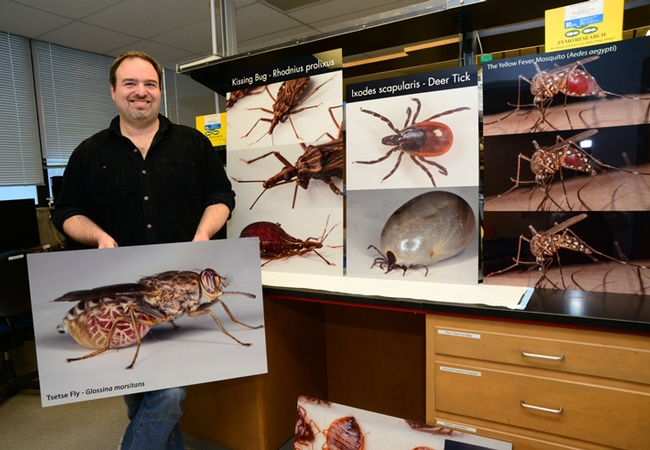
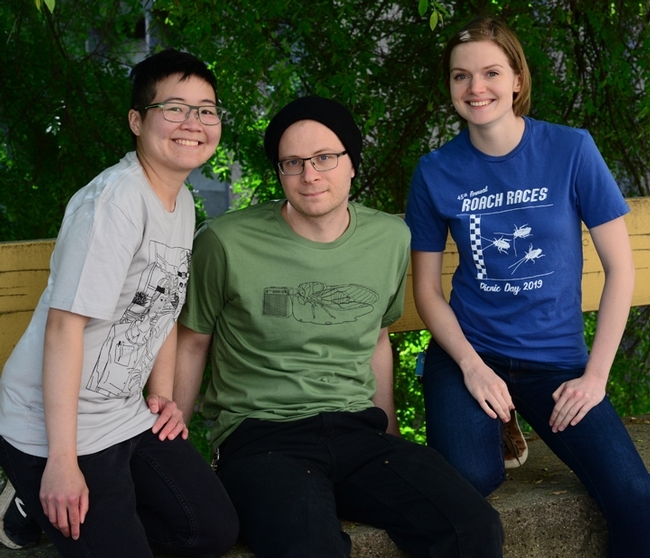
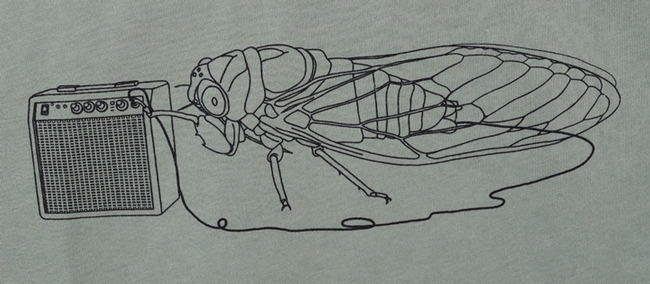
- Author: Kathy Keatley Garvey

Insects are in. They're not only everywhere in nature (well, almost everywhere!), they've climbed, crawled, jumped, buzzed, fluttered, flew or otherwise positioned themselves on fashions, including the UC Davis Entomology Graduate Student Association (EGSA) t-shirts.
The EGSA, comprised of UC Davis graduate students who study insect systems, is an organization that "works to connect students from across disciplines, inform students of and provide opportunities for academic success, and to serve as a bridge between the students and administration," according to EGSA president Brendon Boudinot, an ant specialist/doctoral student in the Phil Ward lab.
As a year-around fundraising project, they sell t-shirts, which can be viewed and ordered online at https://mkt.com/UCDavisEntGrad/. Jill Oberski, a graduate student in the Phil Ward lab, serves as the t-shirt sales coordinator. She can be reached at jtoberski@ucdavis.edu.
Oberski designed an award-winning onesie, “My Sister Loves Me." It's an adult ant, “loosely based on Ochetellus, a mostly-Australian genus.”
Boudinot's award-winning design is REPRESANT, with illustrations by colleague Eli Sarnat, an alumnus of the Ward lab.
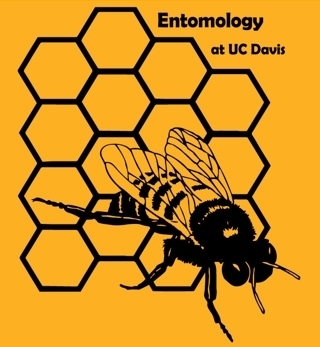
One of the favorite bee t-shirts depicts a honey bee emerging from its iconic hexagonal cells. It's the 2014 winner by then doctoral student Danny Klittich, now a California central coast agronomist.
Another "fave" bee shirt--this one showing a bee barbecuing--is by doctoral student and nematologist Corwin Parker, who studies with Steve Nadler, professor and chair of the UC Davis Department of Entomology and Nematology. It was one of the 2018 winners. (See the three winners on this site.)
EGSA is heading for the Entomological Society of America annual meeting in November. In addition to their participation, the graduate students will be selling shirts at the meeting, appropriately themed "Sharing Insects Globally." It's set for Nov. 11-14 in Vancouver, B.C. The EGSA also sells its t-shirts at other events, including at Briggs Hall during the annual UC Davis Picnic Day.
Insects rock. But some climb, crawl, jump, flutter, buzz, fly or otherwise position themselves on EGSA t-shirts.
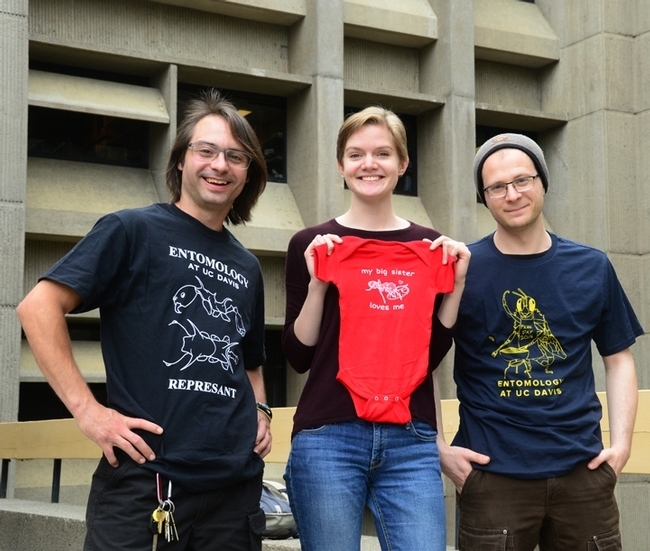
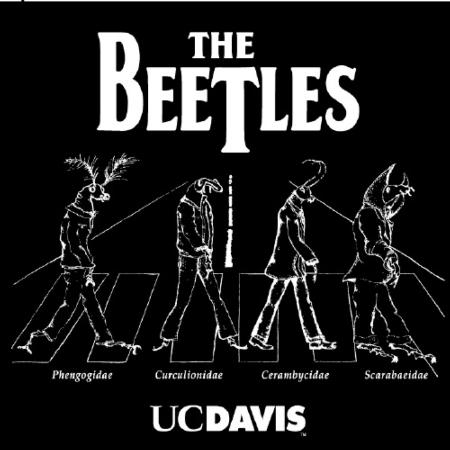
- Author: Kathy Keatley Garvey
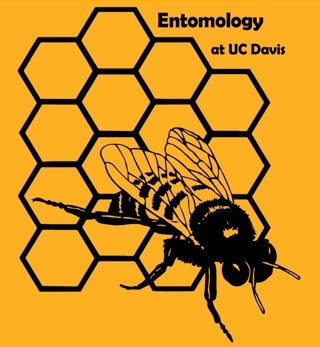
How about wearing a pollinator on your heart?
It's National Pollinator Week.
The UC Davis Entomology Graduate Student Association (EGSA) offers a wealth of t-shirts as part of its year-around fundraising efforts. It's for a good cause. The EGSA, comprised of UC Davis graduate students who study insect systems, is an organization that "works to connect students from across disciplines, inform students of and provide opportunities for academic success, and to serve as a bridge between the students and administration," according to EGSA president Brendon Boudinot, an ant specialist/doctoral student in the Phil Ward lab.
The t-shirts can be ordered online at https://mkt.com/UCDavisEntGrad/, according to medical entomologist and EGSA treasurer Olivia Winokur, a doctoral student in the Christopher Barker lab. She serves as the t-shirt sales coordinator and can be reached at ocwinokur@ucdavis.edu.
One of the favorite bee t-shirts depicts a honey bee emerging from its iconic hexagonal cells. It's the 2014 winner of then graduate student Danny Klittich, who recently received his doctorate in entomology from UC Davis and now works as a California central coast agronomist.
Another "fave" bee shirt--this one showing a bee barbecuing--is by doctoral student and nematologist Corwin Parker, who studies with Steve Nadler, professor and chair of the UC Davis Department of Entomology and Nematology. It was one of the 2018 winners. (See the three winners on this site.)
Pollinators also include butterflies, birds and beetles.
"The Beetles" t-shirt is EGSA's all-time best seller. Instead of the English rock band John Lennon, Paul McCartney, George Harrison and Ringo Star crossing Abbey Road in single file (that's the iconic image on the cover of their album, Abbey Road), think of The Beetles (four insects) crossing Abbey Road in single file. Beneath the images of the beetles are their family names: Phengogidae, Curculionidae, Cerambycidae and Scarabaeidae. Think glowworm, snout, long-horned, and scarab beetles.
One thing's for certain: Pollinators matter. Not just during National Pollinator Week but every day of the year.
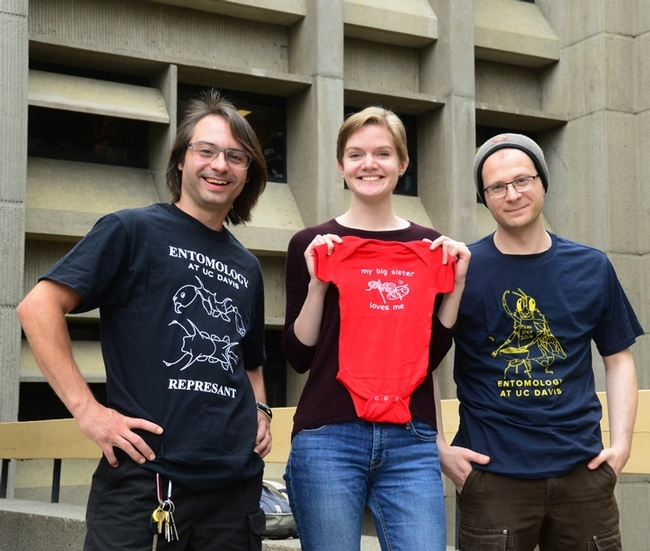

- Author: Kathy Keatley Garvey
Quick question:
What was diagnostic parasitologist Lauren Camp of the UC Davis Veterinary Medical Teaching Hospital wearing on her head as she talked about the nematode collection last Saturday at the seventh annual UC Davis Biodiversity Museum Day?
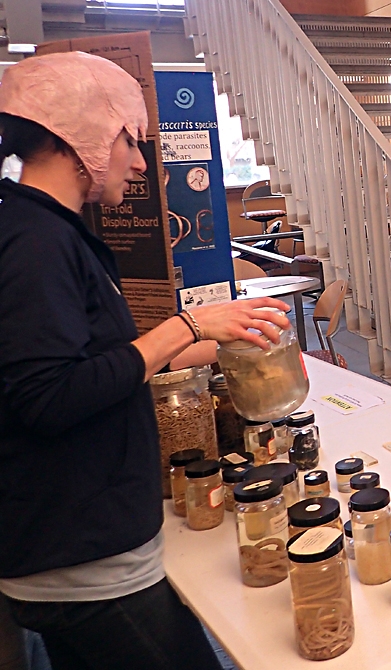
“The hookworm in that image is a parasite of dogs,” explained Camp, who received her doctorate in entomology in 2016 from UC Davis, studying with major professor Steve Nadler, chair of the Department of Entomology and Nematology. “This nematode lives in the small intestine of dogs, and is pretty small, at around 14-16 mm. Dogs can have no symptoms from this parasite, but the parasite can be fatal in some cases. Some of the hookworm samples I showed on Saturday were red because hookworms eat blood from their hosts in addition to eating the intestinal lining. Importantly, Ivana Li made the hat for me using papier mache!”
That would be entomologist Ivana Li, a UC Davis biology lab manager who received her bachelor's degree in entomology from UC Davis in 2013.
Among nematologists staffing the collection, displayed from 1 to 4 p.m. in the Sciences Laboratory Building, were graduate students Corwin Parker and Chris Pagan, who study with major professor Steve Nadler.
Camp, who hails from rural northern Indiana, first became interested in parasites as an undergraduate student at the University of Chicago, where she received her bachelor's degree in biology in 2005. She went on to earn her master's degree in biology from Wake Forest University in 2007 and her doctorate from UC Davis in December 2017. Her doctoral research focused on the genetic characterization of raccoon roundworm, a zoonotic nematode, in North America.
Camp joined the Clinical Diagnostic Laboratories Parasitology Lab in August 2017. Her responsibilities include looking through feces to find and identify parasites. “Many of these parasites are nematodes,” she points out.
"My specific interest in nematode parasites developed when I read some of Dr. Nadler's work on the evolutionary relationships of nematodes for an invertebrate biology class," she related.
Nematologists are accustomed to answering "What's a nematode?"
In one word, "worms."
“Nematodes are an amazing phylum of organisms--they exist in almost every known environment on the planet, and different species eat everything from bacteria and fungi to plant and animal tissue," Camp told us back in 2017, prior to setting up a display at the Bohart Museum of Entomology open house on Parasite Palooza. "I find parasites particularly fascinating, because they are dependent on another organism (or organisms) for part or all of their life cycle."
Camp appeared Sunday, Jan. 22, 2017 on Good Day Sacramento's "Parasite Palooza" show with entomologist Jeff Smith, curator of the moth and butterfly specimens at the Bohart Museum of Entomology. They shared and showed specimens and live insects. Camp mentioned a 30-foot-long whale nematode. (See http://gooddaysacramento.cbslocal.com/video/category/spoken-word-good-day/3610653-parasite-palooza/). Her public service activities also include speaking to Capital Public Radio. (See http://www.capradio.org/88726.)
